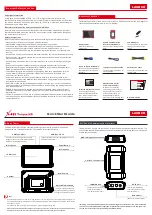
Instruction Manual | 9
2. Release the pipetting pushbutton slowly and smoothly
to aspirate the sample. Wait one second and then
withdraw the pipet tip from the liquid. If the pipet tip
is not immersed to the recommended depth or if the
pipetting pushbutton is rapidly released, air may enter
the disposable pipet tip.
NOTE:
Avoid touching the orifice of the pipet tip.
Dispensing
3. Place the end of the pipet tip against the inside wall
of the vessel at an angle of 10° to 40°. Press the
pushbutton smoothly to the first stop. Wait one second.
4. Press the pushbutton to the second stop to expel any
remaining liquid. Keep the pushbutton depressed to the
very end, and remove the pipettor by drawing the pipet
tip against the inside surface of the receiving vessel.
5. Release the pushbutton to its starting position.
6. Eject the pipet tip by pressing the tip ejector button.
Remember to change the pipet tip whenever a different
type of liquid is to be sampled.
Filters
A replaceable filter (L), fitted in a seat in the bottom part
of the shaft, is used in 5,000 μL and 10,000 μL pipettors.
This filter prevents the aspirated liquid from entering
into the shaft and thus from contaminating the inside of
the shaft and the piston. Using the filter is particularly
important when aspirating and dispensing large volumes
of liquid.
If the filter becomes wet during liquid aspiration it should
be replaced with a new one.
4. Pre-rinsing
When pipetting liquids of higher viscosity or lower surface
tension than water (e.g., sera or organic solvents), a film
of liquid is formed on the inside wall of the pipet tip. This
film can create an error. As the film remains relatively
constant in successive pipetting operations with the same
tip, this error can be eliminated by forming the film before
transferring the first sample. This is done by aspirating a
sample and dispensing it back into the same vessel. Now,
as the film is already formed, all of the following samples
will have better accuracy and repeatability.
This pre-rinsing operation should be repeated when the
volume to be aspirated is changed or when a new pipet tip
is used.










































